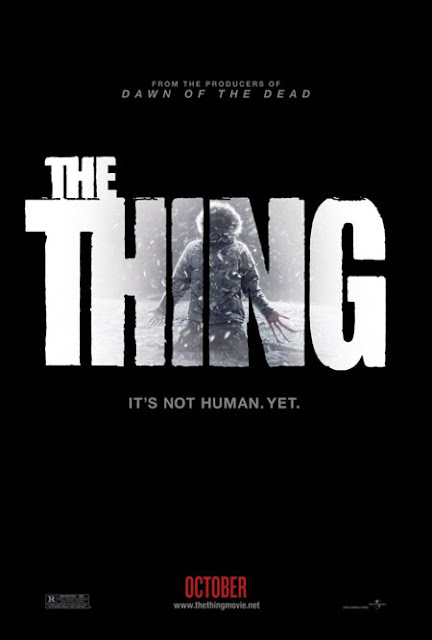Part of my bias may be due to discovering Carpenter's version on cable. Anyone familiar with that edit knows that all of the characters are introduced by name in a voice over, and it carries over in the memory to watching the film as the director intended. Still, even without that, all of the characters are distinct and seem to have a purpose for being stuck at a remote science station during the winter of 1982. Made in its own time, the characters seem to be refugees from what America became after the Vietnam War and the domestic turmoil that persisted from the '60s into the '70s. More importantly, they were all men. The inherent struggle for dominance associated with surging testosterone is only heightened by the dangerous situation that befalls them.
Van Heijningen, Jr.'s version is largely lacking that. The new story – set to tell the tale of what happened to allow the thing into the American camp – makes a few mistakes right off the bat. For some reason, four Americans (really three and a Brit of African heritage) take center stage early on. My informed guess is that this was done to avoid having the entire film with Norwegian dialogue (never mind that there are several easy cheats around that). In introducing the central character, Kate Lloyd (Mary Elizabeth Winstead), the film effectively begins in the civilized world. The sense of isolation and loneliness that was present in Carpenter's version is lost because of this. The tension that is supposed to exist between Lloyd and Norwegian team leader Dr. Sander Halvorson (Ulrich Thomsen) feels forced; none of it feels rooted in the battle of the sexes that should be playing out with a woman brought into the environment. Even that is ruined because there is already a woman stranded down at the Antarctic station.
Because the only characters who seem to get developed seem to be Lloyd, Dr. Halvorson, Adam Goodman (Eric Christian Olson), Lars (Jørgen Langhelle), and Braxton Carter (Joel Edgerton), the impending danger and deaths have little emotional resonance. Likewise, there isn't much reason given as to how or why Lloyd comes to be the leader. Again, I have to assume this was a cheat to give the film a different dynamic than Carpenter's. When the action comes, it moves along at a decent pace but doesn't allow for any introspection or examination of what has happened. It kind of becomes action for the sake of action.
 |
| Kate Lloyd (Winstead) has no qualms about torching the thing, but she isn't in a hurry to just lay waste to everything. |
Sure, the alien ship looks more like it belongs in Predator 2 (1990) than the 1982 version. The action inside it feels like what should have been present in The X-Files: Fight the Future (1998). At the point in the movie where that action comes, the real question posed to the audience is whether or not the thing (or one of them) can be kept from escaping destruction. If you are going to have a shapeshifting alien as your monster, you may as well embrace the dynamic spaceship that brought it to Earth.
I didn't like the '11 version of The Thing as much as I hoped I would. It isn't bad, and I have a feeling that people who have not become so familiar with Carpenter's version that they feel like Windows with Let's Make a Deal when watching it will find this engaging and mildly suspenseful. Because so much of the format is retained, however, a knowledgeable viewer will see much of what they have already seen before. I wouldn't discourage people from seeing it, even those who may feel disinclined to give the prequel a chance. I think it makes good use of the newer special effects technology (with two exceptions, one of which is a creature type and the other a mode of attack) and does not try to replicate the roles of the American camp. If I were to give it a grade, I would rate it a solid B.

No comments:
Post a Comment